
Station Name: THORNTON-IN-CRAVEN[Source: Alan Young]
Thornton-in-Craven Station Gallery 1: c1906 - Early 1963 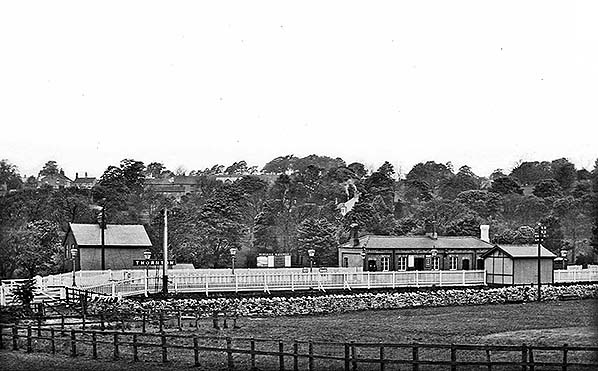 Thornton station looking north-west c1906. This unusual angle provides much valuable information about the buildings and fixtures as well as the site of the station in relation to Thornton village, seen on the hill in the distance. The single-storey station building, constructed of brick under a hipped slate roof, is on the up (Skipton-bound) platform; although it possesses modest dignity it does not look entirely at home in a landscape of rustic stone houses. The back of the timber waiting shed with its pitched roof is seen on the down platform. The two-storey stationmaster’s house, with smoke issuing from its chimneystack, is seen far left. It is an undistinguished building constructed c1900. The running-in nameboard gives the station name in its original form, as ‘in Craven’ was not officially added until 1937, although it had been used in various publications for several decades. The elegant Midland Railway lamp standards and the notice board bearing the company’s name will be noted. The fences are not of the distinctive Midland ‘diagonal’ style, and they and the crossing gates have been given a coat of brilliant white paint – perhaps in anticipation of this photograph being taken?
Copyright photo from John Alsop collection 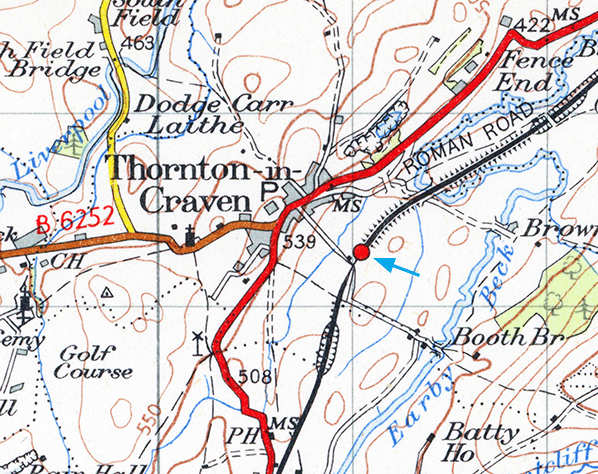 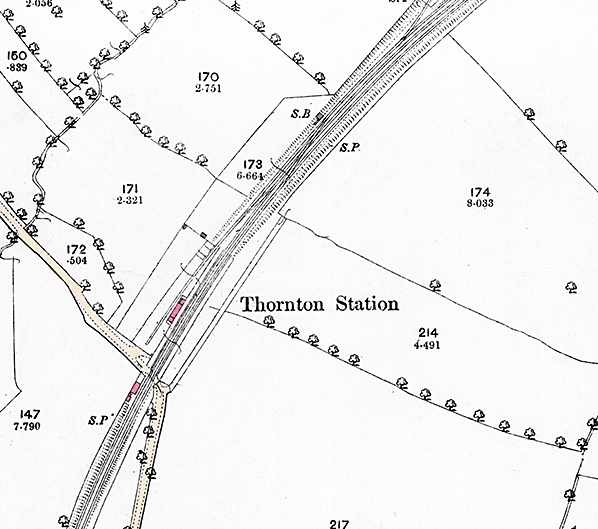
1894 1:2,500 OS Map. At this date the only building at Thornton station is on the up (north-west, Skipton-bound) platform; the station house would soon be added. The signal box (SB) and signal posts (SP) are shown as is a siding behind the up platform. The westernmost of the three tracks north-east of the station is for goods and mineral traffic, and at the northern edge of this map extract the siding diverges towards Thornton limestone quarry. There are no buildings apart from those connected with the railway on this map, and even today the station site remains isolated from Thornton-in-Craven village.
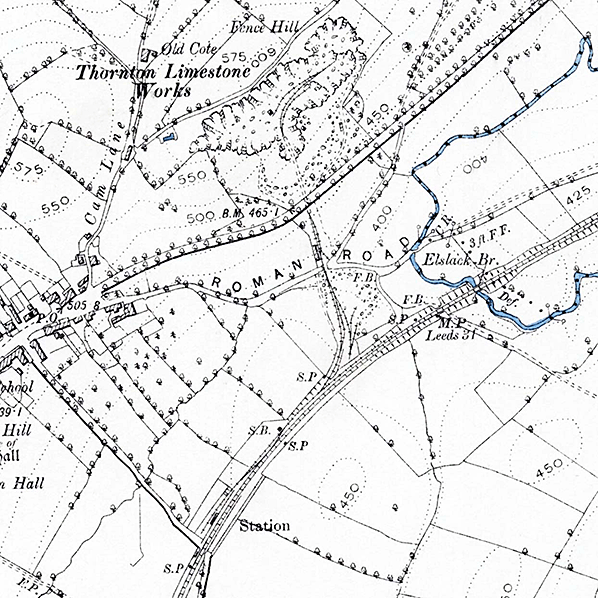
1894 1: 10,560 OS map.Thornton-in-Craven village, railway station and quarry are shown on this map. The station is about ¼-mile from the village, reached by a lane without any housing development. At this date the map indicates that the only building at the station is on the up (north-west, Skipton-bound) platform; the station house would soon be added. The signal box (SB) and signal posts (SP) are shown as is a siding behind the up platform. The quarry, named ‘Thornton Limestone Works’ is reached by a siding from the Skipton-Colne line which passes over the ‘Roman Road’, the old road to Skipton, before tunnelling under the present-day route to emerge at the southernmost extent of the quarry. Sidings for stone traffic branch from the line into the quarry. Click here for a larger version.
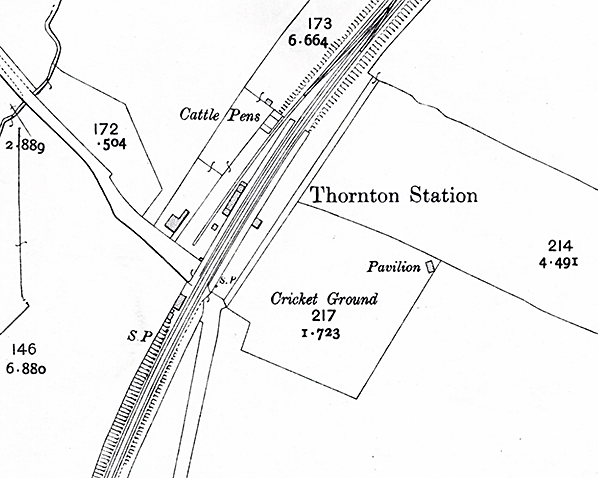 1934 1: 2,500 OS map (Survey 1909). The station has reached its fullest extent. It was not until 1937 that the suffix ‘in Craven’ was officially added to the station name, although it had appeared in various documents for several decades. The building on the up platform is shown with its internal divisions and it faces a small shelter on the down platform. The station house has been added since the map of 1894, placed close to the lane (Station Road) and north-west of the siding that serves the cattle dock. The siding continues beyond the northern edge of this map extract to diverge northwards to Thornton Limestone Works, as seen on the 1894 map. The signal box can be seen about 200yd north-east of the station; it is positioned midway between the station and the point where quarry siding curves away from the main line. The village cricket ground is adjacent to the station – and is still here in 2017.
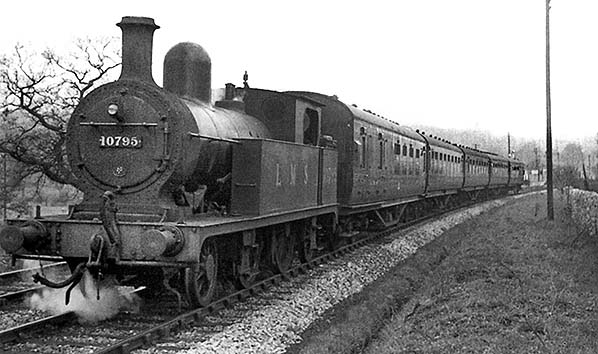
Photography of railways was prohibited for security reasons during World War 2, so pictures taken at that time are rare; however, local resident M N Clay photographed locos at work at Thornton-in-Craven. This view on 30 April 1940 shows a five-coach Skipton to Blackpool train near Thornton-in-Craven, headed by ex-LYR Class 2P 2-4-2T No.10795. The Aspinall-designed Lancashire & Yorkshire Railway Class LYR5 locomotive was built in May 1898 at the company’s Horwich works and carried LYR number 1378. At nationalisation in the loco would be shedded at 23A Skipton and given BR number 50795. She was withdrawn from 20E, Manningham shed, on 30 November 1959 and disposed of in June 1960 at Gorton works.
Photo by M N Clay from late Donald Binns collection 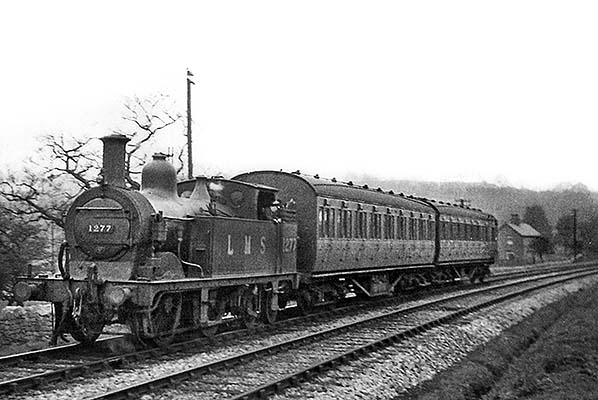
In April 1940 a push-and-pull set is speeding towards Thornton-in-Craven station (seen far right) propelled by No.1277, an ex-Midland Railway ‘1532’ Class 1P 0-4-4T. This Johnson-designed locomotive was built in May 1881 at the Midland Railway’s Derby works. She was withdrawn from 23A, Skipton shed, in May 1946 and cut up at Derby.
Photo by M N Clay from late Donald Binns collection 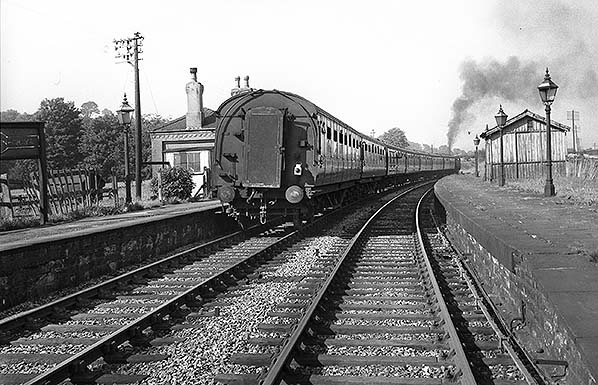
An undated view looking north-east of an up passenger train passing Thornton-in-Craven station. Part of an LMS ‘Hawkseye’ nameboard is seen far left. The station’s condition has deteriorated, with damage to the fences and the platforms and down waiting shed looking showing signs of neglect. The Midland Railway oil lanterns are of interest, with their casements set at an approximately 45° angle to the platforms.
Photo from Ted Burgess collection 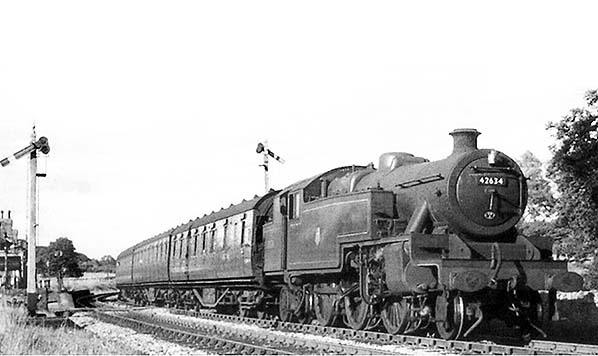 On 4 August 1956 Class 4P 2-6-4T No.42634 is leaving Thornton-in-Craven station on a Skipton to Manchester train. The lower quadrant signals will be noted. The Stanier-designed locomotive was built at the LMS Derby works in September 1938. At nationalisation in 1948 she was based at 24A, Accrington shed, and she remained in action until January 1965 when she was withdrawn from 10A, Wigan Springs Branch shed, to be cut up by Maden & McKee, Stanley, Liverpool the following May.
Photo by M N Clay from late Donald Binns collection 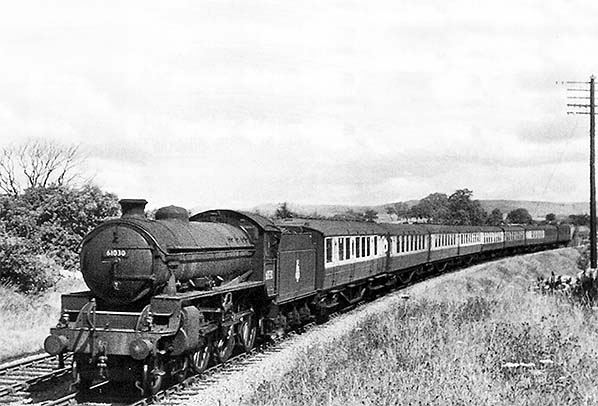
A nine-coach Saltburn-Blackpool summer Saturday express is passing Thornton-in-Craven on 4 August 1956. Such holiday trains were a familiar feature on Britain’s railways until the mid 1960s when the combined effects of increased car ownership, holidays abroad, and the policy to withdraw them signalled in the ‘Beeching Report’ of 1963, drastically reduced their number. The loco is No.61030 ‘Nyala’, a Thompson-designed B1 ex-LNER 4-6-0 built at Darlington works in June 1947. British Railways prefix ‘6’ was added to the original LNER number 1030. Originally allocated to 51E, Stockton shed, at nationalisation, she was withdrawn in September 1967 from 25F, Low Moor shed, to be cut up by Garnham, Harris & Elton, Chesterfield, in November 1967. At Colne LMS/BR(LMR) motive power would replace this B1 with a ‘Black Five’ or similar to haul the train to Blackpool. The afternoon train would go through the opposite operation with the waiting B1 taking it into BR(NE) territory.
Photo by M N Clay from late Donald Binns collection
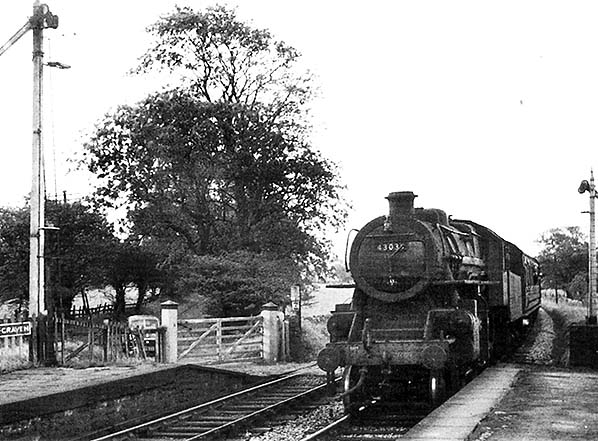
An early morning local train from Skipton is passing over Booth Bridge Lane / Station Road level crossing and entering Thornton-in-Craven on 30 September 1957. An LMS ‘Hawkseye’ nameboard is attached to the fence, far left. Lower quadrant signals are still in place, both in the ‘Off’ position. The locomotive is Ivatt-designed Class 4F 2-6-0 No.43035 built at Horwich works in May 1949. She was withdrawn from 11D,Tebay shed, in November 1965 and cut up by Motherwell Machinery and Scrap. Inslow Works, Wishaw in February 1966.
Photo by M N Clay from late Donald Binns collection 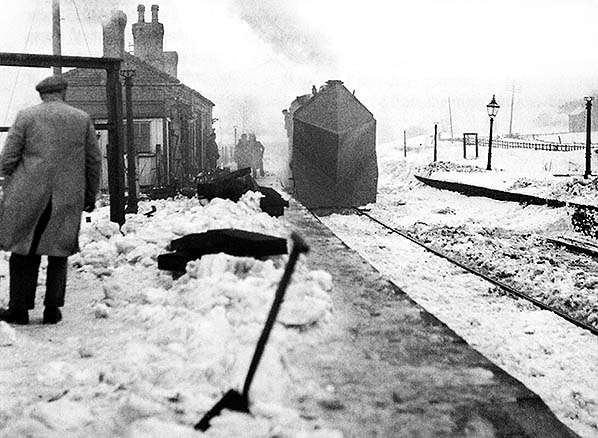 In early 1963 there was prolonged snow cover in much of Britain, and this evocative view north-eastwards on the up platform of Thornton-in-Craven station was taken during that period. A Skipton-based Class 4F 0-6-0 with snow-plough fitted is on hand, while a shovel is in place for clearing the platform. A few weeks later the ‘Beeching Report’ would list this station for closure, and it is already looking decidedly run down, with the empty LMS nameboard frame and decapitated lamp standards. In early 1963 there was prolonged snow cover in much of Britain, and this evocative view north-eastwards on the up platform of Thornton-in-Craven station was taken during that period. A Skipton-based Class 4F 0-6-0 with snow-plough fitted is on hand, while a shovel is in place for clearing the platform. A few weeks later the ‘Beeching Report’ would list this station for closure, and it is already looking decidedly run down, with the empty LMS nameboard frame and decapitated lamp standards.Photo by G Tonks Click here for Thornton-in-Craven Station Gallery 2:
|
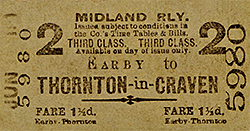 The station had facing platforms on the double-track railway. The main building on the up (north-west) platform contained the booking and waiting facilities and was of the same style as that at Elslack, the next station towards Skipton. It was of brick construction, a single-storey structure of modest dignity. The roof was hipped and the door and window openings were segmental arches. Some decoration was supplied by dentillation of the cornices. On the down platform was an austere timber-built, enclosed waiting shed with a pitched roof. Platform lighting was by oil throughout the station’s life, the casements supported by standards bearing the Midland Railway’s initials.
The station had facing platforms on the double-track railway. The main building on the up (north-west) platform contained the booking and waiting facilities and was of the same style as that at Elslack, the next station towards Skipton. It was of brick construction, a single-storey structure of modest dignity. The roof was hipped and the door and window openings were segmental arches. Some decoration was supplied by dentillation of the cornices. On the down platform was an austere timber-built, enclosed waiting shed with a pitched roof. Platform lighting was by oil throughout the station’s life, the casements supported by standards bearing the Midland Railway’s initials.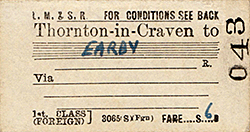 In January 1923 when the ‘Big Four’ Grouping took place the Midland Railway became part of the new London, Midland and Scottish Railway (LMS). It was under LMS management that the station formally became Thornton-in-Craven, and the company installed its distinctive ‘Hawkseye’ nameboards carrying the full name. During the 1920s and ’30s competition from road motor transport increased, and buses could serve Thornton directly, and the station’s location some way from the village proved to be a disadvantage. The 1938 timetable, below, indicates that trains ceased to make evening calls at the station, with the exception of the 6.45pm down departure on Sunday. The lonely lane between the village and station might have been a deterrent to would-be passengers at that time of day.
In January 1923 when the ‘Big Four’ Grouping took place the Midland Railway became part of the new London, Midland and Scottish Railway (LMS). It was under LMS management that the station formally became Thornton-in-Craven, and the company installed its distinctive ‘Hawkseye’ nameboards carrying the full name. During the 1920s and ’30s competition from road motor transport increased, and buses could serve Thornton directly, and the station’s location some way from the village proved to be a disadvantage. The 1938 timetable, below, indicates that trains ceased to make evening calls at the station, with the exception of the 6.45pm down departure on Sunday. The lonely lane between the village and station might have been a deterrent to would-be passengers at that time of day.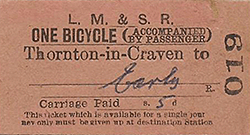 Having successfully escaped extermination in 1959, the Reshaping of British Railways (‘Beeching Report’) of March 1963 recommended Thornton-in-Craven’s closure whilst sparing the Colne Branch; predictably, the service from Earby to Barnoldswick was listed for withdrawal. The residents of Thornton-in-Craven seemed unmoved by the possibility that their station might close with the Craven Herald reporting that people found buses far more convenient because of the distant situation of the station. Many threatened stations were to close within three years of the report, but Thornton-in-Craven cheated the executioner once again and remained open and staffed throughout the 1960s. However, with its future uncertain no investment was made in the station, and by the mid 1960s its appearance had become distinctly shabby. The shelter on the down platform had been removed and most of the lanterns disappeared, leaving a row of decapitated columns. British Railways nameboards were not fitted, and at least one of the LMS boards lay on the platform for some time having fallen from its frame. The summer 1964 timetable shows a threadbare service; the down Saturday-only departures are daily weekday trains which omit calls at Thornton on Monday-to-Friday. No trains call on Sunday.
Having successfully escaped extermination in 1959, the Reshaping of British Railways (‘Beeching Report’) of March 1963 recommended Thornton-in-Craven’s closure whilst sparing the Colne Branch; predictably, the service from Earby to Barnoldswick was listed for withdrawal. The residents of Thornton-in-Craven seemed unmoved by the possibility that their station might close with the Craven Herald reporting that people found buses far more convenient because of the distant situation of the station. Many threatened stations were to close within three years of the report, but Thornton-in-Craven cheated the executioner once again and remained open and staffed throughout the 1960s. However, with its future uncertain no investment was made in the station, and by the mid 1960s its appearance had become distinctly shabby. The shelter on the down platform had been removed and most of the lanterns disappeared, leaving a row of decapitated columns. British Railways nameboards were not fitted, and at least one of the LMS boards lay on the platform for some time having fallen from its frame. The summer 1964 timetable shows a threadbare service; the down Saturday-only departures are daily weekday trains which omit calls at Thornton on Monday-to-Friday. No trains call on Sunday.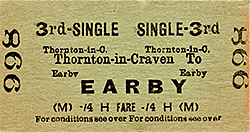 The trackbed through the station site is a public footpath. Several hundred yards north-east of the station the route of the siding into Thornton Quarry (locally known as Thornton Rocks) can be followed across the bridge over the old road to Skipton as far as the tunnel portal. The abandoned quarry can be reached by a steep footpath through the woods west of the A56. The quarry is flooded, apparently with some equipment in place below the water, and it is popular with divers. The north portal, where the tunnel emerged in the quarry, is still visible but access to it requires both care and courage.
The trackbed through the station site is a public footpath. Several hundred yards north-east of the station the route of the siding into Thornton Quarry (locally known as Thornton Rocks) can be followed across the bridge over the old road to Skipton as far as the tunnel portal. The abandoned quarry can be reached by a steep footpath through the woods west of the A56. The quarry is flooded, apparently with some equipment in place below the water, and it is popular with divers. The north portal, where the tunnel emerged in the quarry, is still visible but access to it requires both care and courage.
 Home Page
Home Page